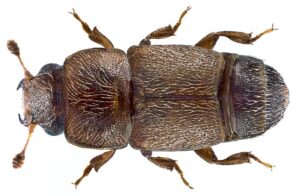
Authors: David Doll and Zubair Shahzad
Carpophilus beetle (Carpophilus truncatus) is a small insect that causes severe damage to almond kernels. The insect overwinters within the soil, and emerges infesting the almonds at hullsplit. They are quite mobile and able to fly up to 3 miles/5km to find a suitable host. Humid conditions increase the emergence and rate of development, leading to multiple generations within a season. More on Carpophilus beetle can be found here.
Damage is highly dependent on the variety, harvest timing, and weather conditions. Soft-shell varieties with poor shell seal are most susceptible. Within Australia, the worse damage is reported on Nonpareil, with minimal damage reported on Monterey, Price, and Carmel. Infestation rates increase when harvest delays occur as the nuts are exposed to multiple generations. Rain between hull-split and harvest often increases damage as it results in a faster rate of insect development and harvest delays.
Effective management depends on both chemical and cultural practices. In severely infested fields, operations have reported success of applying clothianidin at 1% hullsplit. Early harvest has been shown to reduce exposure and corresponding damage. Nonpareil harvest completion should be targeted by the end of August in the northern hemisphere/February in the southern hemisphere.
Winter sanitation is critical to reduce Carpophilus beetle populations. Mummies serve as the initial food source for the beetles as they exit the soil. Operations should target <5 mummies per tree after sanitation. Nuts should be destroyed as soon as possible after winter shaking as the beetle emerges from the soil as it warms.
Current trapping methods do not have a lure specifically for C. truncatus. General lures for Carpophilus beetles are available and can be used within bucket traps. Although not providing species level population dynamics, it can provide insight on the emergence of carpophilus beetles and the relative population. This could be useful in timing sprays and monitoring general pressure. This may change once a new lure under development is released.
Once established within an orchard block, this pest is difficult to control due to its lifecycle stage in the soil. Operations should integrate all operations possible to reduce the risk of establishment and spread.

